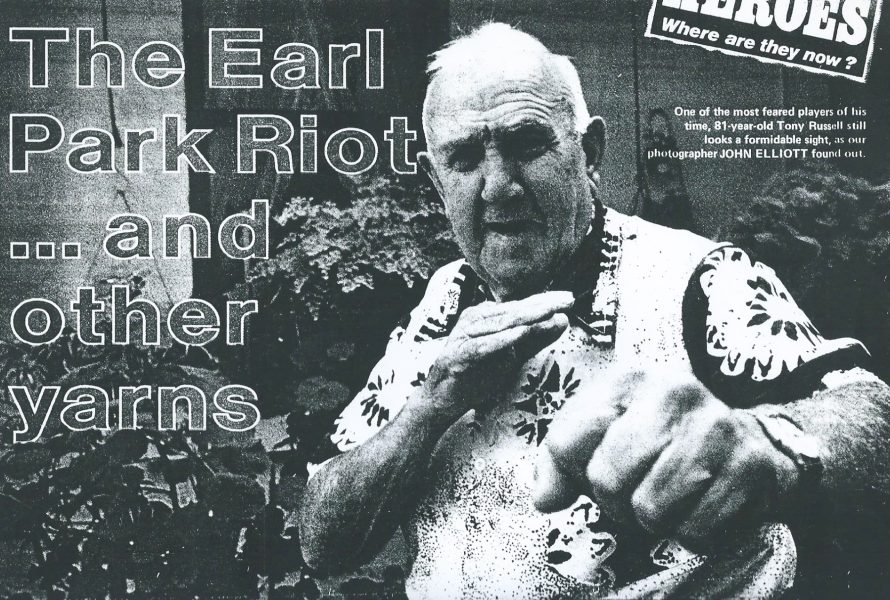TONY RUSSELL Controversial world champion
The world of 18 footer sailing, and many of the men who sailed the boats, in the early years of the 20th century was a far-removed type of sailing to the professional racing and competitors who steer their high-tech machines around Sydney Harbour in 2023.
Fuelled by individual wagering between two rival crews or spectator gambling with organised bookmakers aboard the following spectator ferries, the racing took on some robust action which occasionally resulted in on-the-water fisticuffs.
Adding to the high-octane situation was the nature of the competitors. Many were first grade professional rugby league footballers with a willingness to bring the violence on the fields of their winter sport to the more sedate venue of Sydney Harbour.
One of the individuals who ‘fit the mould’ of such a competitor was Tony Russell who played first grade rugby league for the Balmain club, from 1926-to-1929, and sailed 18 footers at the Sydney Flying Squadron and NSW 18 Footers Sailing Club.
The obvious highlight was his victory, as skipper, of Marjorie Too at the 1949 World Championship on Sydney Harbour.
In an era of tough men in a brutally physical game, Tony Russell was regarded as ‘temperamentally unfit’ for rugby league following a series of incidents that made rugby league history.
In the 1920s, Earl Park was the home ground for the St George District Rugby League Football Club, and on 11 August 1928 etched its name into rugby league history with what became known as the ‘Earl Park Riot’.
In a torrid match between St George and Balmain, there was no love lost between the two teams and the passionate local supporters became very upset when one of their players was sent from the field early in the second half.
Despite their ‘disappointment’ at the send-off, it wasn’t until five minutes from the end of the match that sent the day into rugby league infamy.
According to reports at the time, it all began when Balmain’s Tony Russell allegedly kicked St George player George Carstairs in the face, after a tackle, while Carstairs was on the ground.
The referee apparently missed the incident and supposedly asked Russell “did you kick Carstairs?” Russell’s reply, “I wouldn’t waste boot leather.”
When the referee elected to warn Russell and didn’t send him off, the crowd were furious and began calling for Russell’s ‘blood’.
Adding to the drama, when full time sounded, another Balmain player decided to settle a personal score with a St George opponent and ‘all hell’ broke loose as St George supporters rushed onto the field to take their own form of justice on the Balmain players.
The violence quickly escalated as the crowd invaded the ground. Fence posts were ripped out and the pickets used as weapons.
Tony Russell was the Saints fans’ Public Enemy Number One.
Police were called to try and calm the scene but it was a lost cause as no matter of protection could save Russell and he was badly beaten by the crowd, and taken to hospital in an ambulance.
Accordng to Russell in a later newspaper interview, “the crowd was so thick they nearly killed me – hitting me in the privates and ribs, and all that sort of thing.”
Incredibly, both Russell and Carstairs ended up in the same ambulance and paramedics were forced to become physically involved when the still angry Russell, despite his injuries, lunged at Carstairs, shouting, “you started this you bastard, now I’m going to finish it”.
Russell spent three weeks in hospital and had 15 head x-rays before he was able to return to Balmain, where he was declared a hero by supporters. Balmain selectors, however, had different ideas and declared him ‘temperamentally unfit’.
Tony was a marked man and only played a few more first grade games.
He later went to the ‘bush’ and had success playing and coaching in three country towns. One of his appointments was quite amusing as it involved an old adversary.
He later recalled in a newspaper interview, I asked the committee if I could meet the previous year’s coach but was told he had left on the last train the night before when he heard I was appointed.’
“When I asked who it was, I was told, George Carstairs.”
After his playing and coaching rugby league career was finished, Tony returned to Balmain where he still managed to find trouble. He threw two Communist organisers into the harbour at Balmain and was accused of ‘flattening’ six men in a Balmain pub.
Considering his rugby league ‘antics’ and the other incidents, it’s not surprising that Russell’s 1949 World Championship victory was controversial and begged the question after the second race, ‘Was it sabotage?’
Top Weight II (Bish Bolton) won the first race by 10s from Russell’s Marjorie Too, with Top Dog III (Joe Pearce) in third place. New Zealand’s Takiri (Vic Speight) had been in fourth place until she broke her spinnaker pole on the last leg and dropped back to finish seventh.
Takiri had protested Top Weight II for a breach of the port-and-starboard rule, but the protest was dismissed. Adding to the New Zealanders’ disgust, no protest was entered by Top Weight II against Marjorie Too after being fouled.
More controversy surrounded the second race, which Marjorie Too won from Crows Nest (George Pearce) and Top Dog III. Takiri finished in fourth place.
Takiri led for much of the race but was dogged by continual spinnaker trouble. Her halyard parted and she was unable to carry her big spinnaker which fell into the water. By the time the crew recovered they had lost the lead, but hung on to finish fourth by using their small spinnaker.
After the race, Takiri’s crew claimed that their brand-new halyard had been deliberately cut ‘as if it had been cut with a knife’.
James Giltinan ridiculed the sabotage claims while the volatile Tony Russell immediately offered to match race Takiri for a 100 pounds wager.
It took the NZ team manager Vern Young to smooth over the situation when he blamed the sharp edges of their new stainless steel halyard blocks.
Despite the explanation, a popular conception remained that it was a bookmaker-influenced act of sabotage.
In the third (final) race, after a tremendous battle with Marjorie Too, Takiri defeated Marjorie Too by 26s, but Tony Russell and Marjorie Too became the 1949 world champions.
Tony Russell’s son, Barry was also a talented 18 footer sailor who won the Australian Championship in 1960-61 with Vic Robinson, in a skiff named The Fox, and was a member of Australia’s 1962 America’s Cup challenger, Gretel I.
Both rugby league and 18 footer racing have come a long way over the past 70-90 years.
Credits: Robin Elliott, Galloping Ghosts; John Steamer Stanley OAM

